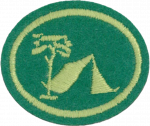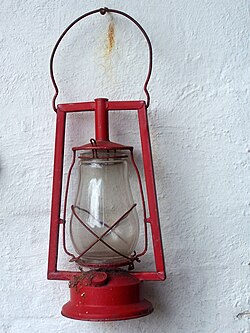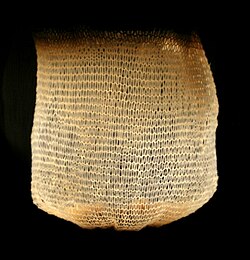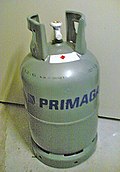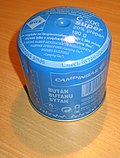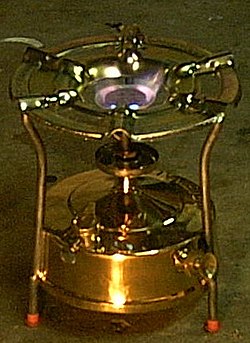Especialidades JA/Campamento III/Respuestas
| Campamento III | ||
|---|---|---|
| Asociación General
|
Destreza: 2 Año de introducción: 1986 |
|
Requisitos
| Conexión Logros para la Investidura: Esta especialidad está relacionada con los requisitos de Logros para la Investidura para EXPLORADOR Vida al Aire Libre que requiere el desarrollo completo de esta especialidad. |
1
Campamento I ha sido diseñado para que esté dentro de las capacidades de los Conquistadores que están en el grado 7 o más alto.
2
Seleccionar Sitio de Campamento
Adventist Youth Honors Answer Book/Camping/Choosing a campsite/es
Seguridad Contra Incendios
Adventist Youth Honors Answer Book/Camping/Fire/Fire safety/es
3
4
4a
4b
4c
5
5a
5b
5c
5d
5e
5f
6
Una herramienta puede ser afilada con una piedra de afilar. La mayoría de las piedras de afilar deben mantenerse húmedas cuando están en uso - algunas están mojadas con agua y otras están mojadas con aceite. Las piedras con grano más fino usan típicamente el aceite, pero puede usar el agua en ellas también. El propósito de mojar una piedra de afilar es permitir que el acero removido del cuchillo se vaya flotando. Cuanto más fina sea la piedra, más fina será la orilla que hará en una herramienta, pero más tiempo tardará en afilarla. Por esta razón, una herramienta muy sin filo debe ser afilada primero con una piedra más gruesa, y luego con una piedra más fina. Entonces debe mantenerse afilado. Puede mantener un cuchillo afilada por respetarla - no corte en el suelo con un hacha y no meta la navaja en el suelo tampoco. La suciedad es muy abrasiva y una roca se dañará la orilla muy rápidamente. Cierre un cuchillo de bolsillo cuando haya terminado de usarlo y no permita que el extremo de la navaja toque nada más que las cosas que está intentando cortar con ella.
Hacha
Es tentador tomar un hacha sin filo a un dispositivo eléctrico, pero a menos que tenga mucho cuidado, esto podría ser un gran error. Una amoladora no sólo eliminará el acero de un hacha, sino que también lo calentará. Es muy fácil calentarlo demasiado, haciendo que el acero pierda su temperamento (el acero templado es duro y tiene una orilla mejor que el acero no templado). El acero es templado calentándolo hasta el punto de que se convierta en no magnético, luego enfriándolo rápidamente. Si se deja enfriar lentamente, los cristales de hierro de la hoja se alinearán con el campo magnético de la Tierra mientras se enfrían, y los cristales alineados hacen el acero blando. Así que el primer consejo que se puede dar al afilar un hacha es mantenerse alejado de una amoladora.
En su lugar, use una lima o una piedra. Sostenga la lima para que pase sobre la orilla de la hoja, pero en un ángulo pronunciado. Afile un lado y luego el otro.
Cuchillo
Para afilar un cuchillo, sosténgalo en un ángulo de 15° y raspe a lo largo de una piedra de afilar, como si estuviera tratando de afeitar una fina capa de la piedra. Asegúrese de afilar ambos lados.
7
8
Adventist Youth Honors Answer Book/Camping/Tent/Styles/es
Diferentes tipos de tiendas de campaña se usan para diferentes propósitos. Una tienda de campaña de 4 estaciones será bueno para cualquier tipo de condiciones, mientras otros tipos de tiendas (la mayoría hoy en día son de 3 estaciones) no son tan buenas en todas las estaciones (usualmente la estación de invierno no es un buen momento para usar tales tiendas de campaña). Entonces, las estaciones son una forma de señalar diferentes tipos de tiendas de campaña.
The different types of camping would be another way to distinguish the types of tents. A family tent is more than likely going to be heavy (weight wise) and bulky. It will often have lots of room (can fit 6 people). A backpacking tent is small and light weight. Usually you won't put gear in a backpacking tent (you hang your pack or keep it out of your tent). A backpacking tent will fit people snuggly (usually no more than 2 per tent). A mountaineering tent can stand the rough climate and terrain in addition to being light weight. Mountaineering tents are designed for some gear to fit inside the tent (thus being a little bit more spacious than backpacking tents). Mountaineering tents may also allow for up to 3 or four people to sleep snuggly in a single tent.
The final way to classify tents by different types is by material used. I don't use this method for teaching camping skills 3 though. Tents may be classified by the materials used to build them (like aluminum poles vs carbon fiber poles, etc.).
9
Each breath a person exhales contains water because of the moisture content of the lungs, throat, mouth and nasal cavity. This moisture rises until it comes in contact with a cool surface such as the inside of the tent, where it condenses.
A good tent will be made of breathable material that allows the moisture to pass through (such as a nylon mesh), and there will be a rain fly on the outside to keep rain out of the tent. Water vapor passes through the mesh and condenses on the fly. It then runs off the underside of the fly and drips off the edge outside the tent.
10
Taut-Line Hitch
Adventist Youth Honors Answer Book/Knot/Taut-line hitch
Two Half Hitches
Adventist Youth Honors Answer Book/Knot/Two half hitches
11
- This is your activity.
12
You should take into consideration where your sleeping area(s) are in relation to these water-related areas. Specifically, water flows downhill, so, you do not want water runoff from the 'sink and dishwashing' or 'shower water' flowing to your sleeping area(s).
Also, the location of the 'latrine' should be considered depending on where you get your water source. For example, you do not want to put the 'latrine' upstream and take your shower and wash your dishes downstream. But pay attention! Just because your latrine is downstream and downhill from you does not mean it is downstream and downhill from other campers. Be considerate. A latrine should never be located within 60 meters![]() of any water supply.
of any water supply.
12a
12b
12c
13
Square Lashing
Adventist Youth Honors Answer Book/Lashing/Square
Diagonal Lashing
Adventist Youth Honors Answer Book/Lashing/Diagonal
Shear Lashing
Adventist Youth Honors Answer Book/Lashing/Shear
Continuous Lashing
Adventist Youth Honors Answer Book/Lashing/Continuous
Adventist Youth Honors Answer Book/Lashing/Simple Object
14
Replace Mantel on Camp Lantern
- As with most things, practice and repetition makes a task simple.
- Turn OFF the gas valve completely.
- Remove the lantern cover and the glass covering. Place these in a safe and stable place.
- Remove any remains of the old mantel. Do this carefully if the lantern is still HOT.
- Tie the new mantel in place on the gas pipe. There is a string around the collar that slips over the gas pipe.
- Pressurize the gas tank.
- Hold a lighted match near the mantel. The mantel should begin to burn. Do not turn on the gas. If your lantern has an electronic ignition, it is still better to use a match when lighting a new mantel for the first time, as the ignition can cause the mantel to break.
- Replace the glass cover and the lantern cover.
- Slowly open the gas valve when the mantel starts to glow brightly.
The mantle is a roughly pear-shaped ramie-based artificial silk or rayon fabric bag made from silk or fabric impregnated with rare-earth metallic salts that will convert to solid oxides after being heated in a flame. A mantle will glow brightly in the visible spectrum while emitting little infrared radiation. The rare earth oxides (cerium) and actinide (thorium) in the mantle have a low emissivity in the infrared (in comparison with an ideal black body) but have high emissivity in the visible spectrum. There is also some evidence that the emission is enhanced by candoluminescence, the emission of light from the combustion products before they reach thermal equilibrium. The combination of these properties yields a mantle that, when heated by a kerosene or liquified petroleum gas flame, emits intense radiation that is mostly visible light, with relatively little energy in the unwanted infrared, increasing the luminous efficiency.
The mantle aids the combustion process by keeping the flame small and contained inside itself at higher fuel flow rates than in a simple lamp. This concentration of combustion inside the mantle improves the transfer of heat from the flame to the mantle. The mantle shrinks after all the fabric material has burnt away and becomes very fragile after this first use.
Demonstrate refilling gas in a Lantern and Stove
- Be sure not to spill any fuel, or if you do, make sure you clean up properly.
Maintain Pressure Pump on a Camp Stove
- Most stoves can use either liquid or gas fuel. Gas-fuel stoves are simpler to operate than liquid fueled stoves. The gas, being already pressurized, flows from the fuel canister into the burner, where it ignites, in the same manner as a domestic kitchen stove.
- Liquid-fuel stoves are more complex because the liquid fuel must be vaporized prior to burning. To accomplish this, the stove design brings the fuel line containing the liquid fuel near the flame of the burner. The heat from the flames converts the liquid fuel to a gas before it reaches the burner, where it mixes with air and is ignited. Some models use a spray system which does not require preheating.
- Most stoves operating with liquid fuels must be heated or primed before the burner is turned on. Many stoves require the operator to open the fuel valve briefly without igniting the fuel, so that it flows into a small pan. This small quantity of fuel is then lit and allowed to burn down. When the fuel valve is opened again, the fuel vaporizes from the heat of the pan. Some stoves do not have this apparatus, and must be preheated by the application of an external heat source such as a solid fuel block.
- In many stoves, the priming pressure is generated by a small hand pump that forces air into the fuel container. As the fuel is consumed, the pressure decreases according to Boyle's Law, so the pump must be operated occasionally during use to maintain steady stove operation.
- In the picture (above/right), the pressure pump knob is also the cover to the fuel tank. This MUST fit on the tank properly. If this cover is not correctly fitted, you cannot pressurize the stove. You would pressurize the tank by operating the pump several times before lighting the stove. During the course of use, you will need to operate the pump again, to maintain the pressure in the tank.
Note
References
- Categoría: Tiene imagen de insignia
- Adventist Youth Honors Answer Book/Honors/es
- Adventist Youth Honors Answer Book/es
- Adventist Youth Honors Answer Book/Skill Level 2/es
- Categoría: Libro de respuestas de especialidades JA/Especialidades introducidas en 1986
- Adventist Youth Honors Answer Book/General Conference/es
- Adventist Youth Honors Answer Book/Recreation/es
- Adventist Youth Honors Answer Book/Recreation/Primary/es
- Adventist Youth Honors Answer Book/Stage 100/es
- Adventist Youth Honors Answer Book/IAConnection/es
- Adventist Youth Honors Answer Book
